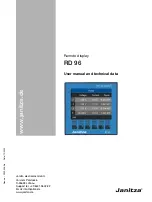
19
Die Probleme im Zylinder können hervorgerufen werden
durch:
A) Verschleiß oder Beschädigung der Kolbendichtung Nr.
27 (siehe Bild 3 auf Seite 23). In diesem Fall ist die
Dichtung zu ersetzen.
B Eines der Maximaldruckventile (Nr. 15A) ist geöffnet.
Dies kann durch Verschmutzung oder durch einen
unkorrekten Sitz der Druckfedern entstehen. Versu-
chen Sie, das Ventil einige Male zu be- und entlasten,
indem Sie den Hydraulikdruck an- und abstellen. Sollte
das Ventil immer noch verklemmt bleiben, ist es
notwendig, den kompletten Zylinder zu demontieren,
und die Innenteile der Maximaldruckventile zu ersetzen.
������
Normalerweise wird nur ein Teil des kompletten Zylinder-
hubs zur Betätigung von Standardfuttem benötigt. Bei der
Bestimmung der Länge des Zugrohres achten Sie bitte
darauf, dass die vordere Endposition im Zylinder erreicht
wird, die hintere Endposition im Spannfutter. Wenn das
Zugrohr falsch ausgelegt bzw gefertigt wurde, macht der
Spannzylinder nicht den korrekten Hub, der für das
jeweilig verwendete Futter notwendig ist.
������
Eine Verkürzung des Zylinderhubes und somit auch
Verkürzung des Backenhubes kann durch unbeabsichtig-
tes Lösen der Zugrohverschraubung erfolgen (sowohl von
der Zylinderseite als auch von der Futterseite). In diesem
Fall schrauben Sie das Zugrohr wieder korrekt ein und
sichem Sie es gegen Öffnen.
������
Überprüfen Sie das Spannfutter auf evtl. Probleme.
������
Das Ansteigen der Öltemperatur wird nur sehr gering vom
Spannzylinder beeinflusst. Es wird hauptsächlich durch
den Hydraulikkreislauf verursacht. Eine korrekt arbeitende
Hydraulikeinheit soIIte auch unter Vollast innerhalb eines
Temperaturbereiches von 35° C – 65° C bleiben. Dies ist
der beste Temperaturbereich um mit dem Spannzylinder
zu arbeiten. Sollte die Öltemperatur im Betrieb über 70° C
steigen ist es notwendig, das Ölvolumen in der Hydrau-
likeinheit zu erhöhen oder einen Ölkühler zu verwenden.
������
Überprüfen Sie den Ölstand in der Hydraulikeinheit. Ein zu
niedriger Ölstand verursacht höhere Temperaturen.
������
Eine unzureichende Schmierung des Spannfutters kann
Geräusche während des Spannvorgangs verursachen.
Zerlegen Sie das Futter und schmieren Sie es mit dem
vorgeschriebenen Fett ab.
������
Beschädigung oder Bruch des Zugrohres oder der Ver-
bindungsgewinde kann ebenfalIs abnormale Geräusche
verursachen. In diesem Fall sind die beschädigten Teile
unbedingt zu ersetzen.
������
Sollten Vibrationen auftreten wenn der Spannzylinder auf
Druck beaufschlagt wird (bei Verwendung von Kraft-
spannfuttern mit Innenspannung oder Spannzangen-
futtern), kann dies durch das Durchbiegen des Zugrohres
aufgrund der Druckbelastung entstehen. In diesem Fall
empfehlen wir den Einsatz von Stützringen aus Bronze
oder Kunststoff, die das Zugrohr am Innendurchmesser
der Spindel abstützen.
������
Eine starke Geräuschentwicklung zwischen dem statio-
nären Ölzuführunsgehäuse und dem rotierenden Teil des
Spannzylinders deutet auf einen Verschleiß oder Beschä-
digung der Lager hin. Dies kann durch verschmutztes Öl
oder normalen Verschleiß hervorgerufen werden. Die
Lager ersetzen, die Filter überprüfen und gegebenenfalls
das Öl ersetzen.
The problems in the cylinder can be caused by:
A) Wear or breakage of the main seal 27 ot the piston (see
illustr. 3 on page 23): in this case, replace the seal.
B) One of the pressure relief valves 15A is open, due to
dirt or to the unsetting of the springs. Try to pressurize
and to relieve the pressure a few times, by switching
the power unit on and off. If the valve still remains
clogged, it is necesary to dismantle the cylinder and
replace the internal components of the valves.
������
Usually, only a part of the cylinder stroke is used to drive a
standard chuck. To determine the length of the connection
draw tube, remember that the front limit switch is on the
cylinder and the rear one on the chuck. If the draw tube has
been wrongly designed or manufactured, the cylinder will
not make all the stroke requested by the chuck.
������
An unexplained reduction in the cylinder stroke (and in the
stroke of the top jaws) can be due to an accidental
unscrewing of the draw tube (both from the cylinder side
and from the chuck side). Screw the draw tube properly
and lock it.
������
There could be some problems in the chuck: check
carefully.
������
The increase in the oil temperature is only slightly
influenced by the cylinder; it is mainly caused by the
hydraulic circuit. A good power unit should be able to keep
the oil temperature between 35° C and 65° C, even in the
worst working conditions. If the temperature is higher than
70° C, it is recommended to increase the oil volume, by
adding an auxilliary tank or by using a system of
temperature conditioning.
������
Check the oil level in the power unit: a reduction in the oil
volume causes an increase in the temperature.
������
Insufficient lubrication of the chuck can cause noises
during the clamping and unclamping of the component.
Dismantle the chuck and grease it with Autoblok "GWT"
grease.
������
Also the partial or total breakage of the draw tube or of the
threads can cause an irregular noise: in this case, replace
the damaged parts.
������
If there are vibrations when the cylinder is in thrust
conditions (both when driving a chuck or a collet), this is
due to the combined bending and compressive stress on
the draw tube. In this case, it is recommended to insert 1
or 2 bronze bushings, to guide the draw tube onto the l.D.
of the spindle.
������
When there is too much noise between the fixed manifold
ring and the rotating part, it is possible that the bearings
are going to have a problem, due to dirty oil or wear.
Replace the bearings, check the filters and change the oil.









































